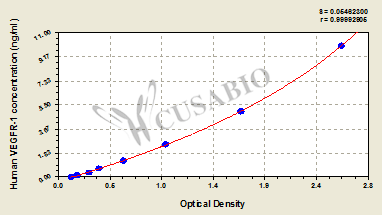The human VEGFR-1 ELISA Kit is used to quantitatively measure human VEGFR-1 concentrations in serum, plasma, or tissue homogenates. It performs well in important characteristics, including sensitivity, specificity, precision, recovery, linearity, and lot-to-lot consistency. This assay is based on the sandwich ELISA mechanism and enzyme-substrate chromogenic reaction. The solution color develops proportionally to the amount of VEGFR-1 in the sample. And the intensity of the color can be measured at 450 nm via a microplate reader.
VEGFR-1, also called Flt-1, is a high-affinity tyrosine kinase receptor for VEGFs, including VEGF-A, VEGF-B, and PIGF. Distinct from VEGFR-2, which participates both in physiological and pathological angiogenesis, VEGFR-1 in the adult is necessary only for pathological angiogenesis. VEGFR-1-VEGF plays an essential role in tumor-related angiogenesis, tissue infiltration, and metastasis formation. Furthermore, VEGFR-1 activation contributes to the recruitment of tumor-associated macrophages (TAMs), cancer immune escape, and stimulation of migration and extracellular matrix (ECM) invasion.






